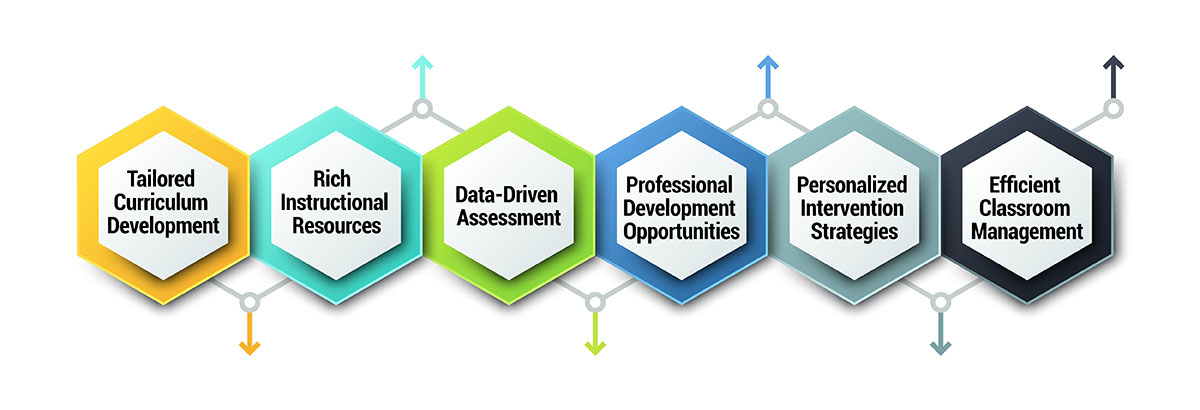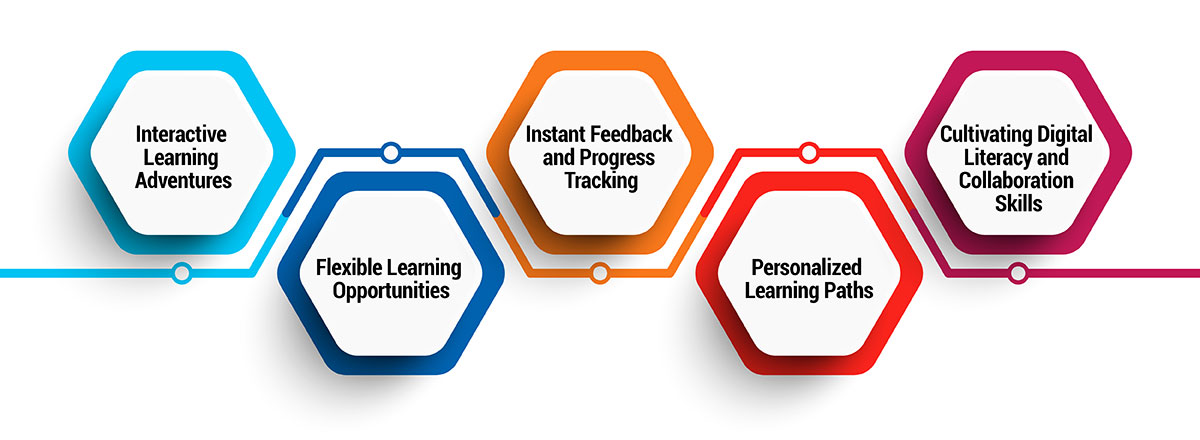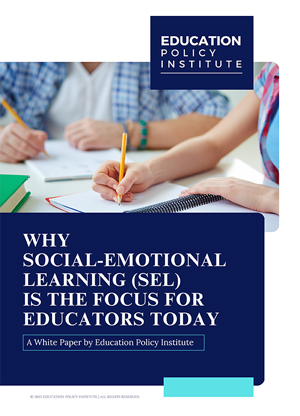Traditional teaching methods, though effective, often fall short in catering to diverse student needs. Entering K-12 learning solutions, bridges the gap with personalized and interactive approaches. By using the latest technology and carefully drawn instructions, these solutions stimulate engagement, critical thinking, and 21st-century skills. Embracing this innovation, educators and students embark on a journey towards academic excellence and individual growth.
Unveiling K-12 Learning Solutions
In today’s rapidly evolving world, the significance of education has never been greater. With a fiercely competitive job market, students must establish a solid educational foundation to thrive. This is precisely where K-12 learning solutions step in.
K-12 learning solutions refer to educational resources, tools, and technologies designed to support teaching and learning for students from kindergarten through twelfth grade. These solutions encompass a variety of methods, including online platforms, interactive software, and personalized instruction, aimed at enhancing the educational experience and improving student outcomes across different subjects and grade levels.
These innovative methods prioritize individual student needs, aiming to make learning engaging, interactive, and accessible. Leveraging technology, games, and personalized instruction, these cater to diverse learning styles and abilities.
A key advantage lies in their flexibility.
Unlike rigid classroom structures, K-12 learning solutions can adapt to each student's unique strengths, weaknesses, and interests. This personalization fosters a more engaging and effective learning experience.
In recent years, the landscape of K-12 education has undergone a transformative shift, accelerated by the pandemic's impact. Online learning tools, including learning management systems (LMS) and cloud-based software, have become indispensable resources for educators and students alike.
As a matter of fact, statistics reveal that a significant uptake of online learning tools have taken place among K-12 students and teachers, with a notable improvement in learning outcomes. Educational videos, software/apps, and eBooks have emerged as popular content types, enriching the learning experience.
Apart from these, K-12 learning solutions offer a myriad of possibilities, simplifying assessment, grading, and communication processes. Interactive training methods bolster retention, while advanced reporting tools provide invaluable insights for content enhancement.
The Boundless Potential of K-12 Learning Solutions
In the dynamic landscape of education, K-12 learning solutions stand as transformative tools, reshaping the way students and teachers engage with content.
These solutions, anchored by Learning Management Systems (LMS), transcend traditional boundaries, offering a multifaceted approach to instruction, assessment, and communication.
-
1. Versatile Content Delivery:
K-12 learning solutions empower educators to diversify content delivery, leveraging multimedia formats like videos, podcasts, and presentations. This flexibility caters to varied learning preferences, enhancing student comprehension and engagement. -
2. Effortless Grading:
With online assessment tools, grading becomes seamless, liberating teachers from cumbersome paperwork. Automated grading streamlines evaluation processes, while plagiarism checks ensure academic integrity. -
3. Enhanced Communication:
Fostered by K-12 learning tools, communication between teachers and students flourishes. Interactive platforms facilitate collaborative learning, nurturing a vibrant online community. -
4. Boosted Retention:
Interactive learning features within K-12 solutions captivate learners, promoting active participation and knowledge retention. Gamified interfaces stimulate curiosity, fostering deeper understanding. -
5. Cost-Effective Education:
Embracing e-learning, K-12 solutions offer cost efficiencies, optimizing resource allocation. LMS platforms enable targeted investments, maximizing educational impact while minimizing expenses. -
6. Streamlined Implementation:
Modern K-12 solutions simplify educational delivery, eliminating the need for extensive physical resources. Accessible content libraries and interactive assessments streamline the learning process. -
7. Expanded Reach:
By transcending geographical barriers, K-12 solutions democratize education, expanding access to learners worldwide. Flexible learning options cater to diverse needs, enhancing inclusivity and enrollment rates. -
8. Tailored Customization:
Personalized learning experiences are at the core of K-12 solutions, allowing educators to tailor content to individual needs and curriculum requirements. Custom libraries offer flexibility and adaptability. -
9. Universal Accessibility:
K-12 solutions break language barriers, offering content in multiple languages and catering to diverse student populations. Interactive videos and global curricula promote inclusivity across all academic levels. -
10. Effortless Reporting:
Advanced analytics embedded in K-12 solutions provide actionable insights, facilitating data-driven decision-making. Attendance tracking and performance reports empower educators to optimize learning experiences.
How K-12 Learning Solutions Guide Teachers
In the realm of K-12 education, learning solutions serve as invaluable tools for empowering teachers and optimizing classroom dynamics.
Here's how these solutions revolutionize the teaching experience:

-
1. Tailored Curriculum Development:
K-12 learning solutions offer customizable curriculum content, allowing teachers to adapt lessons to suit diverse student needs and learning styles while ensuring alignment with educational standards. -
2. Rich Instructional Resources:
Teachers gain access to a wealth of multimedia resources, from videos to interactive simulations, enriching their instructional delivery and fostering engaging learning experiences for students. -
3. Data-Driven Assessment:
With built-in assessment tools, teachers receive real-time data on student performance, enabling them to identify strengths and weaknesses promptly. Automated grading features streamline the evaluation process, providing swift feedback to guide instructional adjustments. -
4. Professional Development Opportunities:
Many learning solutions include professional development modules, equipping teachers with the latest educational insights and fostering collaboration among peers for ongoing growth and support. -
5. Personalized Intervention Strategies:
Adaptive technologies within learning solutions cater to individual student needs, allowing for tailored learning paths. Teachers can utilize data analytics to pinpoint students requiring additional support or enrichment, facilitating targeted intervention strategies. -
6. Efficient Classroom Management:
Learning solutions streamline administrative tasks, freeing up teachers to focus on meaningful interactions with students. From attendance tracking to communication tools, these platforms enhance classroom efficiency and communication.Through K-12 learning solutions, teachers unlock a world of possibilities for student engagement, academic achievement, and professional development, ultimately transforming the educational landscape for the better.
How K-12 Learning Solutions Guide Students
Students are at the heart of the K-12 learning revolution, that enrich their academic journey and ignite their passion for learning.
Here's a closer look at how K-12 learning solutions empower students:

-
1. Interactive Learning Adventures:
K-12 learning solutions infuse education with excitement by incorporating interactive content such as gamified lessons, simulations, and multimedia resources. These engaging experiences captivate students' attention, transforming mundane lessons into thrilling adventures that spark curiosity and fuel a love for learning. -
2. Flexible Learning Opportunities:
With K-12 learning solutions, students enjoy the freedom to learn at their own pace. Whether they need extra time to grasp challenging concepts or desire to explore advanced topics, these solutions provide a flexible environment that accommodates diverse learning styles and preferences.Students can access a wealth of educational resources, including e-books, videos, and tutorials, empowering them to take control of their learning journey.
-
3. Instant Feedback and Progress Tracking:
Automated assessment tools offer students immediate feedback on quizzes and assignments, enabling them to gauge their understanding and identify areas for improvement.By tracking their progress over time, students can set learning goals and monitor their achievements, fostering a sense of accountability and empowerment in their academic pursuits.
-
4. Personalized Learning Paths:
Adaptive learning technologies tailor instruction to meet each student's individual needs, ensuring that they receive targeted support and guidance.Whether students require remedial assistance or seek advanced challenges, personalized learning paths empower them to reach their full potential by addressing their unique learning requirements and goals.
-
5. Cultivating Digital Literacy and Collaboration Skills:
Engaging with K-12 learning solutions equips students with essential digital literacy skills needed for success in today's technology-driven world. Through collaborative tools and platforms, students collaborate on group projects, honing their teamwork and communication abilities while engaging in meaningful learning experiences.K-12 learning solutions revolutionize education by placing students at the forefront of their learning journey.
By harnessing the power of technology and innovative teaching methodologies, these solutions empower students to become lifelong learners, critical thinkers, and active participants in shaping their future.
Conclusion
K-12 learning solutions play a pivotal role in transforming the landscape of education, offering boundless opportunities for both teachers and students.
With specialized instruction, interactive content, and data-driven insights, these solutions empower educators to meet the diverse needs of students while keeping a culture of lifelong learning.
K-12 learning solutions also benefit students by providing engaging, personalized learning experiences that develop curiosity, critical thinking, and academic growth.
By embracing innovation and benefitting from technology, K-12 learning solutions pave the way for a brighter future, where education opportunities are limitless.





